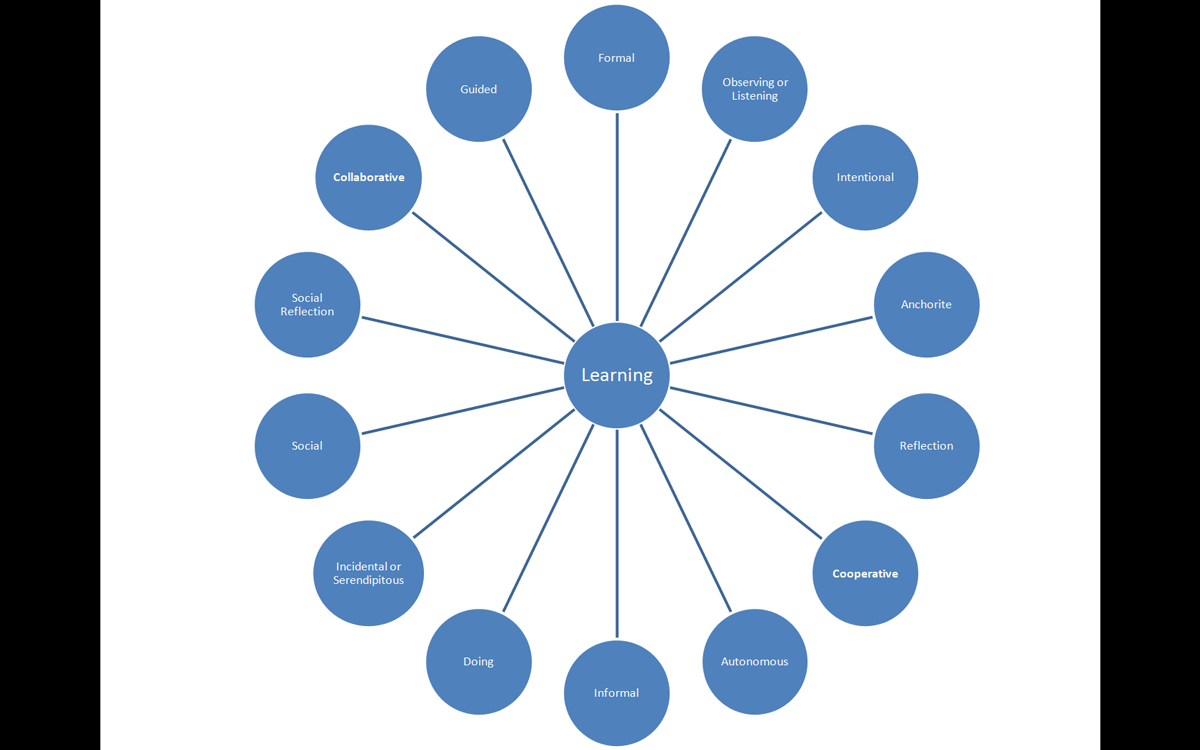I have been doing some more reflecting on the Social Learning and Reflection Continuum. This reflection includes both social reflection (mostly via Twitter) and self-reflection. Part of it includes how the continuum fits in with other continuums and does the Social Learning and Reflection Continuum really make sense? I created the diagram below to see what would happen if I changed it and how other forms of learning fit in. If you click the diagram it will bring up a larger diagram in a new window:
In the diagram I replaced the Social Learning and Reflection Continuum with Social Learning and Achorite. This was mostly because of some tweets with Marcia Conner (@marciamarcia) where she thought that Solitude should be on the opposite side of Social Learning. I did not really like that word so I used the term anchorite, which in part means “rural countryside” in order to contrast it to social, as meaning village or town” (e.g. it takes a village or number or people).
NOTE: While the opposite ends of the various continuums discussed below may be a choice of one or the other, they are more often shades of various degrees and/or combinations. That is, don't just look at the ends, but also picture a wide rage of possibilities inside of them.
The Door

I had the thought, “What is the real purpose of the continuum? Is it to count the number of people involved? Or does it have a deeper meaning.” Then I remembered of what I read when the physicist Freeman Dyson commented on the subject. He noted that when writing, he closes the door, but when doing science, he leaves it open. This is because when writing you need to perform deep reflective thoughts, but when doing science you welcome being interrupted because it is only by interacting with other people that you get anything interesting done.
Thus it is not really about the number of people involved in the learning episode, but rather, do you welcome the thoughts of others or do you need to sort out your thoughts and ideas without being interrupted? Counting the number of people in a learning episode does not make sense as it sort of like counting the number of seats in formal learning — who cares? The real purpose is do you need to discuss ideas with others or do you need to sort ideas, order them, toss out invalid ones, etc. within your own mind.
So I named this continuum “the door” – do you need it open or shut during a specific point when learning? And of course you may decide to choose a combination and have Social Reflection — engaging with others in a way that encourages talking with, questioning, or confronting, to aid the reflective process by placing the learner in a safe environment in which self-revelation can take place.
Thus, I am now sticking with my initial premise that reflection belongs on the same continuum with social learning.
Direction of Control

David Winter (@davidawinter) thought perhaps that Autonomous should be placed opposite of Social Learning. At first I thought his term was better than Achorite or Solitude. But then I thought some more and decided that Guided Learning was really its opposite, thus in the first diagram above I have them on their own continuum. But when I started to name them, it dawned on me that they had the same purpose as the Formal and Informal Continuum — who controls the learning? Since Autonomous and Guided Learning has slightly more precise meanings than Formal and Informal, I placed them on the inside of the Direction of Control Continuum.
Known or Unknown?

Collaborative Learning is quite similar to cooperative learning in that the learners work together in teams to increase their chance of deeper learning. However, it is a more radical departure from cooperative learning in that there is not necessarily a known answer. For example, trying to determine the answer to "how effective is reflection?" would be collaborative learning as there are a wide ranges of possibilities to this question, depending upon the learners' experiences and perspectives.
Purpose of Learning

I included a Purpose of Learning Continuum as learning normally has a purpose during an informal or formal episode, but often we learn something that was not in the initial plan. However, that learning may prove later to have a real and important purpose.
Processing

The processing continuum is important because it determines how we will learn something. If it is easy to learn, we may only have to listen, observe, feel, etc. But as it becomes more complicated, we need to actually do it. Of course that is not always possible, so between the two ends of the continuum are the various activities that we may practice in order to be able to perform in a real work setting.
Workflow

While writing this post, I thought of another learning continuum, workflow — can the learning be embedded within the learner's workflow or does it call for a training process?
Thoughts?
What are your thoughts on these various learning continuums? Are there more? Do these make sense? Please let me know by leaving a comment, Twitter me (I'm @iOPT), or carrying the discussion further on your own blog (send me a tweet so I can RT it).




